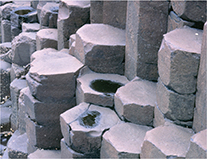Igneous Rock
An igneous rock is a rock that forms from magma. Magma is a mixture of molten rock and gases, including water vapor, which forms underground. Magma that flows out of volcanoes is called lava.  Igneous rock forms when molten material cools and solidifies either inside Earth or at the surface. An igneous rock that forms underground from hardened magma is called an intrusive rock. An igneous rock that forms at Earth's surface is called an extrusive rock.
Igneous rock forms when molten material cools and solidifies either inside Earth or at the surface. An igneous rock that forms underground from hardened magma is called an intrusive rock. An igneous rock that forms at Earth's surface is called an extrusive rock.
Extrusive rocks and intrusive rocks have differences in texture caused by differences in how the rocks formed. Intrusive rocks cool slowly underground, allowing their crystals to grow large. Large crystals give intrusive rocks a coarse-grained texture. Extrusive igneous rocks cool very quickly at the surface. Their crystals do not grow much before the rock cools. This gives extrusive rocks a fine-grained texture.
An igneous rock's color gives a clue to its mineral composition. The rock's composition depends on the composition of the magma from which it was formed. Magma that is rich in iron and magnesium produces rocks that are dark and dense, such as gabbro, an intrusive rock, and basalt, an extrusive rock. Some igneous rocks are less dense and lighter in color than basalt and gabbro. These rocks have a high silica content. One such rock is granite, a coarse-grained, intrusive rock.
Figure 15 Basalt is a fine-grained, extrusive rock. As this basalt cooled, the rock formed into hexagonal columns.

Quick Lab
Observing the Size of Crystals
Materials
salol, plastic spoon, 2 watch glasses, tongs, hot plate, hand lens, Petri dish, ice cube, watch with second hand
Procedure 
Use the spoon to place just enough salol on two watch glasses to cover an area 0.5 cm in width. CAUTION Handle the watch glasses with care to avoid breakage. Salol is poisonous. Don't get it on your skin or breathe its vapor.
Turn the hot plate on to medium heat. Use tongs to place one watch glass on the hot plate.
When the salol is almost fully melted, use tongs to place the watch glass on the table. Use the spoon to gently sprinkle a few crystals of salol on the melted salol. Record the time.
Use a hand lens to observe the salol as it cools. Record the time when salol crystals begin to reform and how large they are.
Place the ice cube on the Petri dish. Repeat Steps 2 to 4 with the second watch glass, but this time, place the watch glass of melted salol on the ice cube instead of the table. Wash your hands with soap and warm water.
Analyze and Conclude
Analyzing Data How did the rate of cooling affect the size of the crystals that formed?
Using Models What characteristic of igneous rocks did this lab model? Explain.
Predicting Pegmatite is an igneous rock that forms when magma cools deep beneath Earth's surface. In contrast, rhyolite is an igneous rock that forms when magma escapes onto the surface. In which rock would you expect to find larger crystals? Explain your answer.





